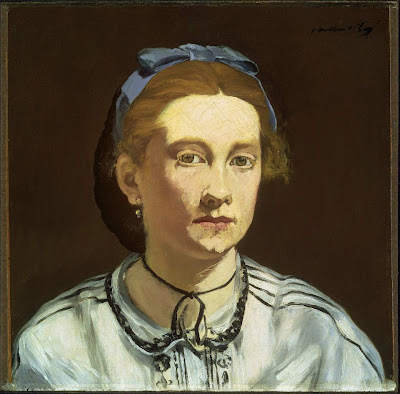A Painter of Spanish Life: Manet's Portrait of Madame Brunet
In 1862 in Le Boulevard, a Parisian news sheet which was a sort of precursor to the L.A. Weekly or the Village Voice, the poet Baudelaire wrote a small article entitled Painters and Engravers. This was one of the few times that Baudelaire, who in his essay The Painter of Modern Life called for artists to search for subjects in the rancor and din of the urban street, wrote expressly about the art of his friend Édouard Manet. Baudelaire wrote,"M. Manet is the author of The Spanish Singer, which caused a great sensation in the last Salon. We will see in the next one a number of paintings by him imbued with the flavor of Spain, which leads one to believe that the genius of Spain has fled to France."
With the news that the Getty Museum has purchased Édouard Manet's Portrait of Madame Brunet, art viewers in Los Angeles will be able to answer for themselves: How did Spanish art influence Manet?
The composition of Manet's Portrait of Madame Brunet seems to be modeled after Goya's etched version of Vélazquez's Portrait of Ferdinand, Cardinal Infante of Spain and Archduke of Austria. Madame Brunet holds her hands in a position similar to Ferdinand and her dark dress stands out against a light filled landscape in a manner that echoes Vélazquez. Further emphasizing the Spanish influence, the background of Manet's Portrait of Madame Brunet bears a striking resemblance to another Velazquez related work - Philip IV as a Hunter which had been acquired by the Louvre in 1862. At roughly the same time that Manet was painting Madame Brunet he was busy at work on an etching based on this very painting.
Even more striking than his compositional borrowings was Manet's use of oil paint. Manet applied the pigment thickly with spontaneous brushstrokes and flowing form that was inspired by the richness found in the paint-work of Vélazquez. In 1865, Manet visited Spain and reveled in the works of the Spanish masters at the Prado Museum (then known as the Real Museo de Pintura y Escultura).
From Madrid, Manet wrote to Baudelaire, "I've really come to know Vélazquez, and I tell you he is the greatest artist that has ever been." Open brushstrokes full of suggestion allow the viewer to enter imaginatively into Vélazquez's paintings and in a sense finish them. Manet applied this idea to subjects of modern life and created a new way of painting.
Scott Allan writes in the Getty Museum's blog The Iris, a rich description of Manet's technique in the Portrait of Madame Brunet:
"The signature elements of his original style are blazingly evident: in the brilliant summary execution of the mesmerizing gloves, the subtle wielding of a nuanced range of blacks in the dress, the sharp silhouetting of contours, and in the radical suppression of half-tones and shadows on the pale oval expanse of Mme. Brunet’s strongly lit face."
Perhaps because of the strength of the painting and the lack of nuanced delicacy, the art critic Théodore Duret recounted that, when Madame Brunet first viewed Manet's painting of her she "began crying and left the studio with her husband, never wanting to see the portrait again."
The soft atmosphere found in the painting of Vélazquez is missing. This suppression of delicate halftones coupled with sharp contours took a number of viewers of Manet's work in the 1860's aback. To many the paintings seemed flat, almost like playing-cards. What was Manet up to they wondered?
The immediacy of Manet's subject matter seemed to call for an immediacy of paint handling. Like a Zen clap, Manet's simplified tonal gradations from light to dark emphasized the force of light.
Other influential examples of flattened spacial compositions made their way to Paris. As Manet was reworking his rejected portrait, the 1867 Universal Exposition opened and the artworks, performers and cultural objects in the Japanese pavilion would inspire new directions in the arts.
Manet painted a view of the exposition grounds and included a Japanese screen and a woodcut of a Sumo wrestler by the Japanese artist Kuniaki in the background of his Portrait of Emile Zola. Hanging next to the Kuniaki print in Manet's witty portrait is an engraving after Vélazquez's painting of Bacchus as well as a reproduction of his own Olympia. In another cross-cultural engagement, less than one hundred and fifty years later Japanese artist Takashi Murakami would bring his own superflat paintings to Versailles.
A French Mona Lisa Comes to L.A.
Getty Acquires Moody Manet








0 Comments:
Post a Comment
<< Home